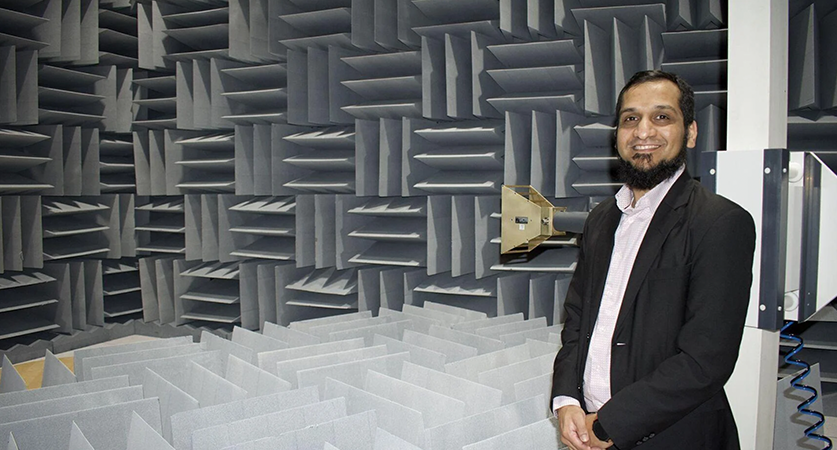Big Ideas: Farhan Ghaffar on improving banked blood storage systems

While we go about our daily lives, researchers at Lakehead University's Orillia campus are busy exploring ways to improve our communities. Big Ideas with Lakehead University Orillia gives you a glimpse inside their innovative work. Keep reading to learn more.
Meet Farhan Ghaffar.
He's an assistant professor in Lakehead University's department of electrical engineering in the faculty of engineering.
Tell us about yourself.
I joined the electrical engineering department in August 2019 as a member of the Lakehead-Georgian Partnership (LUGC) program working out of the Barrie campus of Georgian College. My area of research is radio frequency (RF) circuits, antennas and system design with wide ranging applications: biomedical systems, autonomous vehicles, smart wireless technologies, space and satellite communications.
How did you come to be interested in researching blood bag sterilization systems?
Before joining Lakehead, I was working as a post-doctoral fellow at Ontario Tech University, where I was introduced to this problem during my collaboration with Best Medical Canada Inc. As a researcher working in RF technology solutions, I’m always eager to find areas where industries are looking for better and improved solutions. Furthermore, I’ve worked on a few biomedical and wearable-related projects before. This problem was in an area I knew and an area where I could apply my research.
Tell us a bit about this research project and about the process you’re going through.
Currently, blood bags are stored in sterilization chambers until they’re used for transfusions in various medical treatments. To keep these products sterilized, they need to be irradiated with gamma- or X-rays to prevent transfusion-associated graft versus host disease (TA-GvHD) and other infections. Medical staff rely on colour sensitive tags to determine the minimum level of radiation received by the product. However, there is no way for them to tell the maximum level of radiation received by the stored products. We wanted to come up with a technique that clearly counts the exact levels of radiation received by these blood bags. Our solution consists of a complete radio frequency identification (RFID)-based tag for blood bags and other related products. The tag includes an electronic radiation sensor, a digital memory, an RF energy harvester, and an RF transceiver with an integrated flexible antenna. Some of these modules have been designed, fabricated and characterized for their performance. Others are currently being investigated to move toward an eventual demonstration of complete RFID tag. We have already published two journal papers and have been granted a U.S. patent on this technology. Another patent is currently under review.
Your team developed a system to minimize the number of disposed blood bags. Can you tell us why this was an important advancement.
The current method for storing blood bags/products is quite inefficient and results in significant waste. I feel this is quite astonishing considering these products are stored for saving human lives. This means that wasting any part of these products greatly minimizes the efficiency of health-care professionals and medical facilities. We want to save every inch of these products and every last drop of blood, so it can be used to save human lives.
What’s the most interesting/surprising/unusual thing you uncovered?
That medical facilities and hospitals can rely so much on electronic and wireless solutions is the best thing that I have come across. I always had some idea that our advanced electronic systems could find applications in biomedical system and solutions. However, working on one such technology hands-on was quite intriguing, to say the least.
How will your research impact (potentially impact) the lives of folks in Simcoe County, Ontario, and Canada?
Since the technology is being developed with a Canadian industry partner, Best Medical Canada Inc., our team expects its practical implementation to happen in Canada before anywhere else. As an engineer, it would be a dream come true to see one of my own work/inventions being applied in health-care facilities in Canada and helping to improve lives in our county, province and country.
How are Lakehead students contributing to this research project?
Although most of the work on this project has been completed, my current graduate students are working on advancing various components of this technology. So, we can say the seeds of my research were born by the blood sterilization system. For example, flexible RF antenna designs are being explored by my students. Similarly, my students are working on advancing reconfigurable components for biomedical technologies, etc.The project was funded through a National Sciences and Engineering Research Council (NSERC) grant and was done in collaboration with Best Medical Canada (BMC).
Big Ideas with Lakehead University Orillia is a partnership with Metroland Media. This article was originally published on Simcoe.com on Sunday, Jan. 7, 2024.

